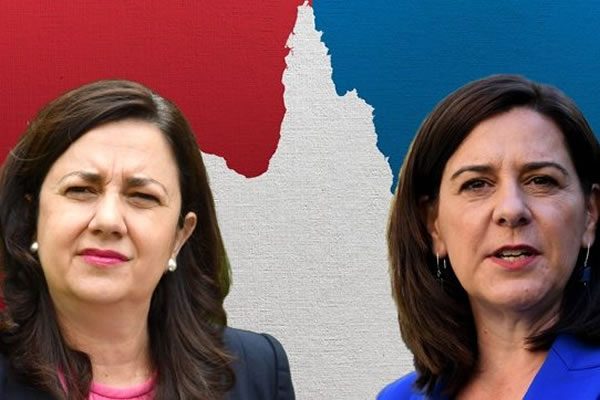We concluded our pre-election post with those immortal words from Peggy Lee “Is that all there is?” Maybe not – let us see what else emerged in this post-election assessment of Labor’s victory.
The Basic Data:

The Labor government was returned in an history-making third term for Annastacia Palaszczuk. But, as the above primary voting data suggests, Queenslanders are not apparently committed to any particular political party. Maybe Queenslanders are more discerning and pragmatically switch allegiance on the perceived merits of parties? Of course, they occasionally make mistakes – for example, at the 2012 election they fell for Campbell Newman but rectified that strongly at the next election.
We earlier depicted the election as being the battle of the 2 Cs – coal and climate. However as the campaign proceeded it became clear there was third C very much in play which became almost overwhelming – Covid19. As we look back over the election, the importance of certain issues begins to surface enabling a more nuanced perspective.
Marching to the beat of different drum? Queenslanders are different and Queensland elections are always different. But first, Annastacia Palaszczuk had an extraordinary victory, both in the north and the south. For the purpose of this post, I have set the cleavage of political Queensland at the holiday mecca of Noosa. South of Noosa the political nomenclature is branded South-east Queensland and the north as “the regions”. Queensland is the most decentralised State in Australia which of itself requires nuanced political strategies. The cities of Rockhampton, Mackay and Townsville are all dependent on coal for their prosperity. Further north including Cairns, tourism and commercial fishing assume importance. The south-east is essentially more urban and environmentally conscious.
History shows that Queensland elections are significantly affected by these regional issues and personalities. But this election was different – regional variations were overlaid by the importance that leadership assumed during the campaign.
That importance was revealed in two critical issue –
- Covid and border closures
- A strategy to minimise the immediate significance of the coal/climate divide
The Palaszczuk government performance over the last term was far from inspirational but, fortunately for the Premier the Opposition was equally as bad. With little else to campaign on, border closures were central to the Government’s re-election strategy.
On the advice of the Chief Health Officer, Dr Jeanette Young, the Premier closed the border despite the protestations of the Federal and NSW governments, and the tourist industry. And resisted the pressures keeping them closed until election day. The Opposition leader Deb Frecklington, who lacks even a hint of gravitas, became erratic with her border announcements and in desperation made the fatal mistake of allowing the PM to assist her. The presence of Morrison merely reminded the electorate of a feeble Frecklington and that the only way the borders would remain closed was to re-elect the Premier. The LNP’s decision to direct preferences to the Greens above Labor did capture the scalp of high-flyer Jackie Trad. A key figure in the Queensland Labor Party since Annastacia Palaszczuk won office in 2015. Trad’s links to the party have run deep and will be missed— she worked as a ministerial advisor in the Beattie and Bligh governments before winning a by-election in 2012. Despite this loss the election proved to be nothing more than a vote for a safe pair of hands!
As an interesting side issue, the possibility of a hung parliament gave rise to speculation of minority government. With Queensland parliament being a single chamber (unicameral) legislature, paths to influence for minor parties are limited. Joining a minority party to assist the forming of government is one such path. Both the possible contenders – the Greens and the Katter party – were prepared to form government with Labor but only Katter with the LNP. Robbie Katter is adamant in recognising that supporting a minority party is his only realistic source of influence. The Greens are in much the same position. To be realistic, the current Full Preferential Voting method would need to be replaced by a form of Proportional Representation such as in NZ for either of these small parties to seriously advance their cause.
Turning to the strategy of minimising the electorally dangerous coal/climate conflict. Palaszczuk adopted an overarching narrative of “jobs, jobs, jobs”, subsuming the climate enthusiasts of south-east Queensland and the coal adherents of the regions under a common ‘motherhood’ objective. Endeavouring to provide a little authenticity in the regions Palaszczuk finally gave Adani the go-ahead with generous royalty provisions attached. Though insignificant in terms of revenue, it was very important symbolically to the regions!
Note that Adani, if it ever gets off the ground, will produce thermal coal. However, it needs to be understood that conflating coking and thermal coal masks an important difference in revenue generation and therefore policy judgments.

Coking coal (used for steel manufacture) royalties contribute an overwhelming 87% of the coal royalties to the Queensland government. Thermal coal (used for electricity generation) contributes less than 10%. (As Qld Treasury points out, penalties for speeding will contribute more to the Qld budget than thermal coal in the next few years.)
This takes us to the critical issue of the future that must be urgently addressed – thermal coal is rapidly approaching technological obsolescence. Thermal coal projects are now only marginally viable and present stranded asset risks. Of the main parties only the Greens have provided serious responses to this issue, the ALP mere tokenism (too difficult), the LNP see it as a source of potential voter exploitation. For the record, and contrary to the Bridget McKenzie – a person of known dubious veracity – estimate of 54000 jobs, there are about 21000 directly employed in thermal coal mining (Source: RMIT ABC Fact Check)
We intend to address this important topic in more detail in a future post.
The views and opinions expressed here are solely those of the author.

